The Plot Twister Worksheets are early conceptual projects by Jenny Liu Zhang. The first prototypes were created by Jenny in November 2018, prior to the founding of the community.
These worksheets are the initial seed of the Plot Twisters vision for bringing self-reflection into the hands of young people. Though most of these were designed and tested between November 2018 and October 2019, takeaways from this work continue to emerge as it influences our approaches to self-reflection and world building today. As such, this case study will be sporadically updated with retrospective details.
Introduction
The Plot Twisters Worksheets are prototypes of self-reflection, habit tracking, goal setting, and emotional regulation practices in the form of visual and verbal exercises. Designed for analog use on paper, Jenny created these worksheets to test certain questions, curiosities, and conceptual metaphors (Lakoff & Johnson, 1980) for understanding qualities of the self. These worksheets specifically focus on values building and behaviors related to learning and work, and they have been tested for various use cases across special needs education, higher education, and student organizations. They are the first Plot Twisters product to operationalize a unified label for referring to our product users, across use cases, as "storytellers." You will see this term in the worksheet descriptions to refer to our users; we continue to refer to our audience as "storytellers" to this today.
These worksheets also demonstrate the conception of many ontological and orientational metaphors for discussing self-knowledge in Plot Twisters: metaphors about challenges use the imagery of lemons, inspired by the phrase, "when life gives you lemons, make lemonade;" motifs of "cookies," to refer to milestones in one's life, and "cookie trails" to refer to commonalities about curiosities, values, and passions across milestones, appear across several worksheets. By introducing these metaphors, we also introduced issues of metaphorical coherence, many of which we have resolved and moved past in later iterations of our world building [pending case study writing]. Therefore, as you explore these worksheets, please keep in mind that the ideas have likely evolved. Though they are early versions of the Plot Twisters project, they can still be printed and used today.
Jump to...
- The Homework Plot Twister
- The Long Foldable Plot Twister
- The Quick Foldable Plot Twister
- Cookie Trail Calculator
- Gift Tagger
The Homework Plot Twister
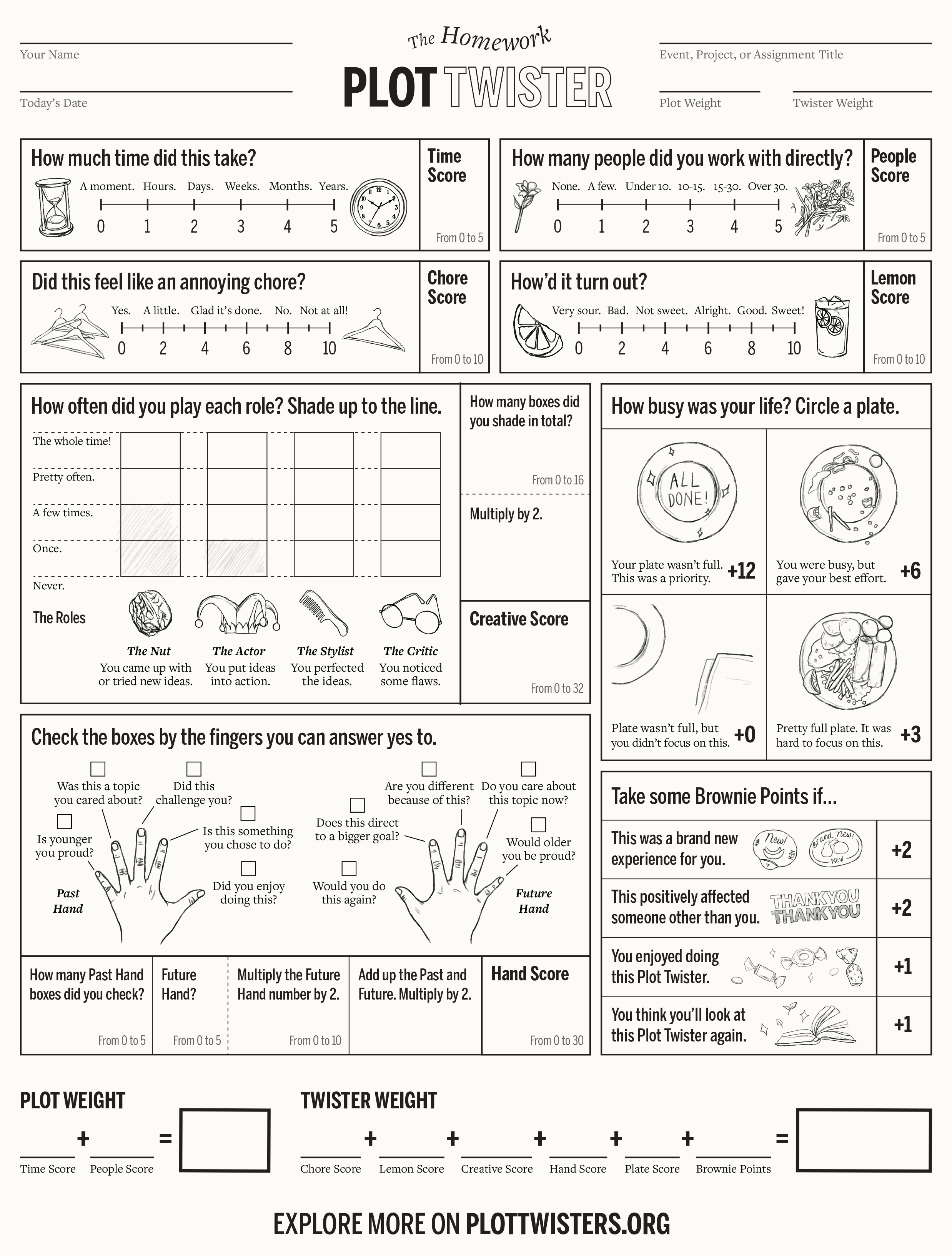 The Homework Plot Twisters asks storytellers to reflect on the details of a project experience by recounting their logistical habits, including meta-roles and time consumption, as well as their feelings toward it as it relates to their past, present, and future.
The Homework Plot Twisters asks storytellers to reflect on the details of a project experience by recounting their logistical habits, including meta-roles and time consumption, as well as their feelings toward it as it relates to their past, present, and future.The Homework Plot Twister is designed to be used after a storyteller completes a school assignment, essay, creative project, or milestone for work to inspire reflection on their process and outcomes. Each module contributes to the overall "scores" of the Plot Twister: the Plot Weight and the Twister Weight. The Plot Weight indicates to the logistical impact of the event in a storyteller's life by accounting for the social aspect of their activity, as well as the duration. The Twister Weight describes the activity's meaningfulness by proposing to quantify ratings of a storyteller's positive feelings, definition of success,creative contributions, busyness, and past and future effects. The higher the total Twister Weight score, the more "meaningful" a project was for the storyteller.
The modules used for scoring were reached by Jenny's own inductive reasoning: the logistical impact of an activity is related to real-world consequences, including number of people involved or affected and the amout of time in their life it consumed. Meanwhile, meaningfulness was determined as a composition of variables related to emotions, environmental context, and values based on particular instances of learning and work in Jenny's life. The model for the creative contributions module, called "Creative Score," is derived from a playful concept by Susan Sontag in a 1961 diary entry about being a writer:
The writer must be four people:1 supplies the material; 2 lets it come out; 3 is taste; 4 is intelligence*.
- The nut, the obsédé
- The moron
- The stylist
- The critic
A great writer has all 4 — but you can still be a good writer with only 1 and 2; they’re most important.
Jenny repurposed Sontag's concept and turned it into a Likert scale-inspired bar graph. Similarly, the "Hands Score" and "Plate Score" modules are scales with weighted options.
This is named the "Homework" Plot Twister because it was specifically created for the use case of students, to take home after finishing a test or class project. Typically after completing a unit in a classroom curriculum, teachers do not assign homework; the Homework Plot Twister is made to be a fun activity in lieu of this gap. The worksheets are designed to be completed consistently over time for several activities throughout a storyteller's learning or work journey, so they can plot their Twister Weights per activity on a timeline to see which projects were the most fulfilling and meaningful.
The Long Foldable Plot Twister
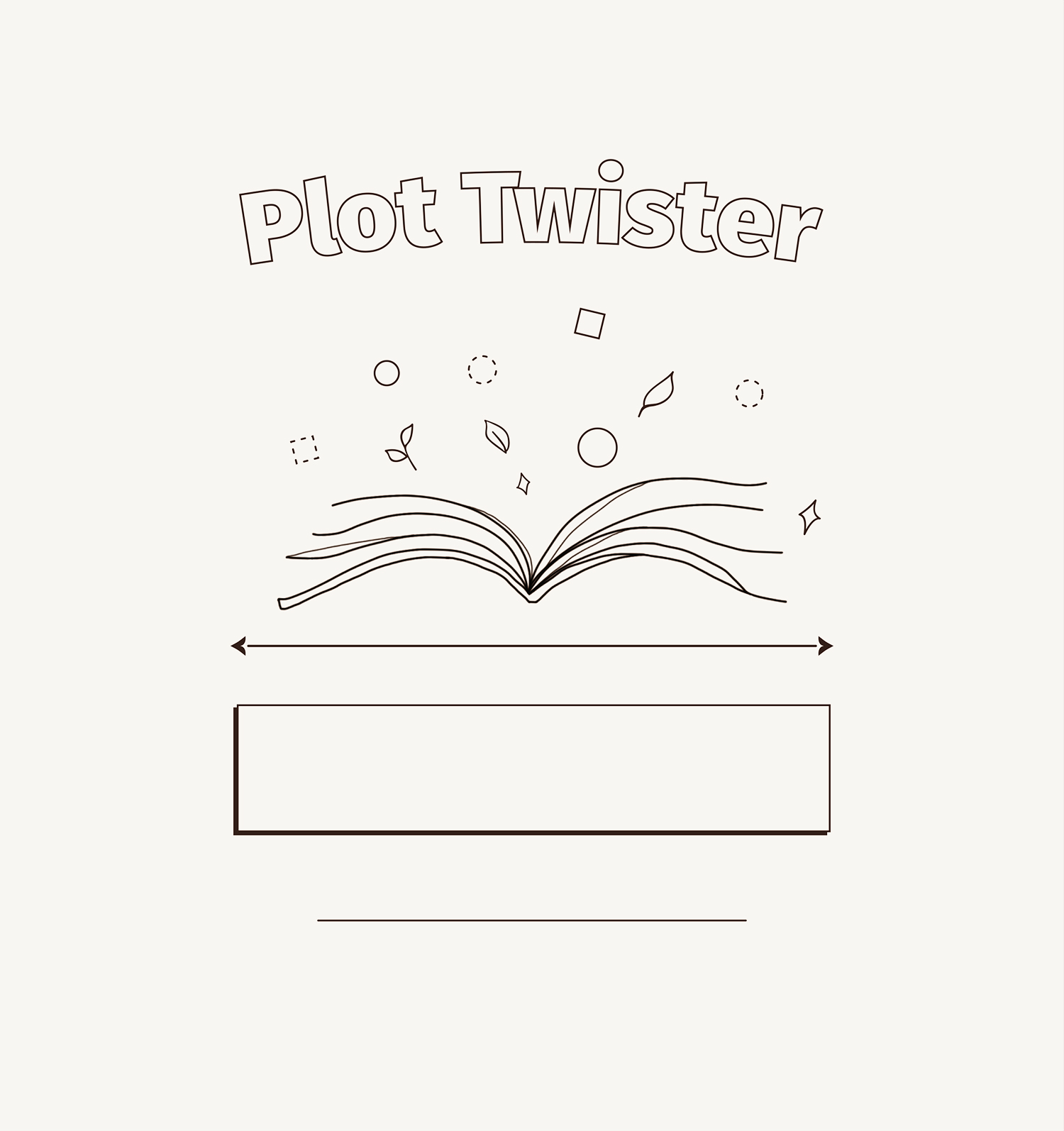
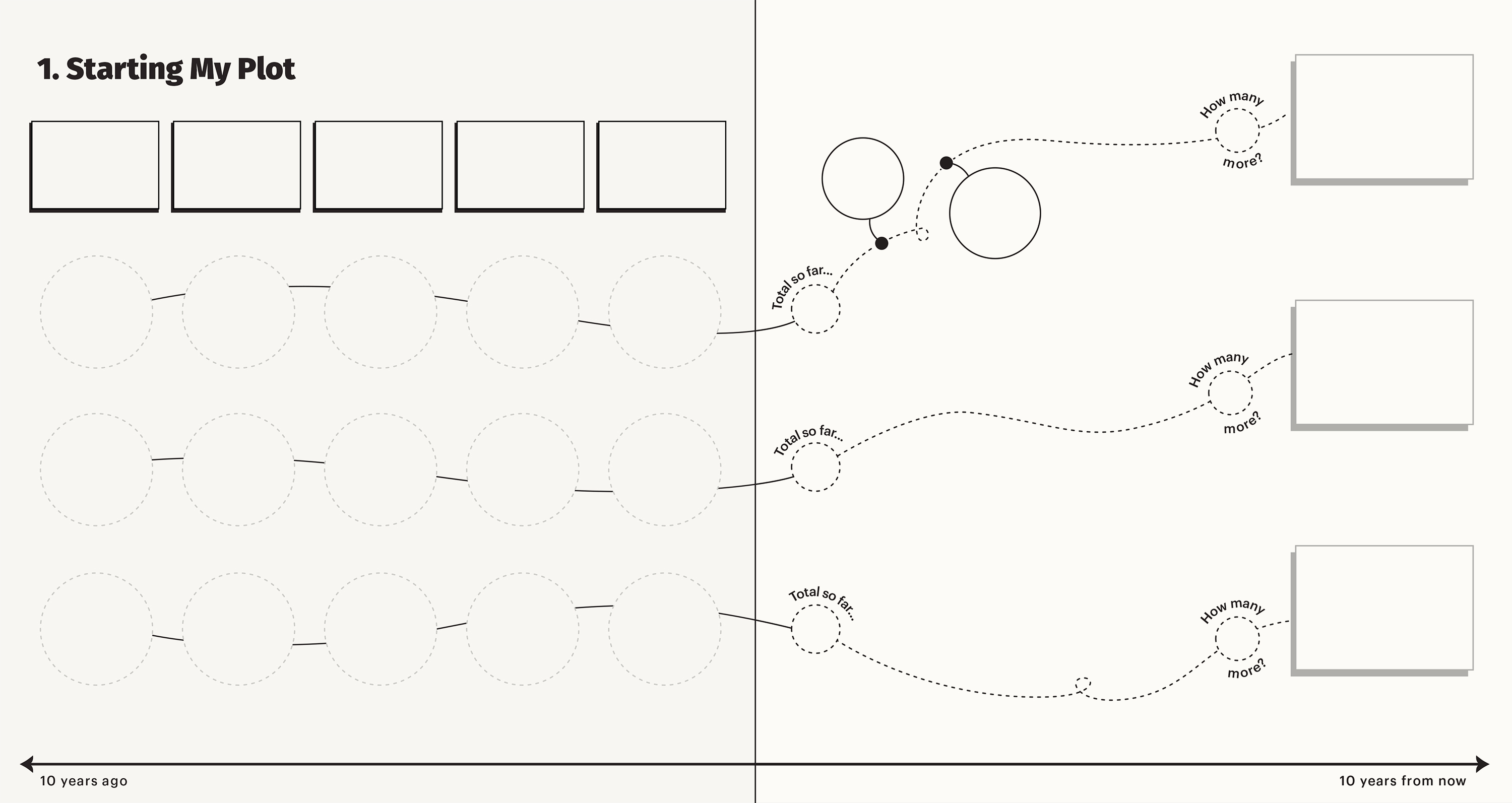
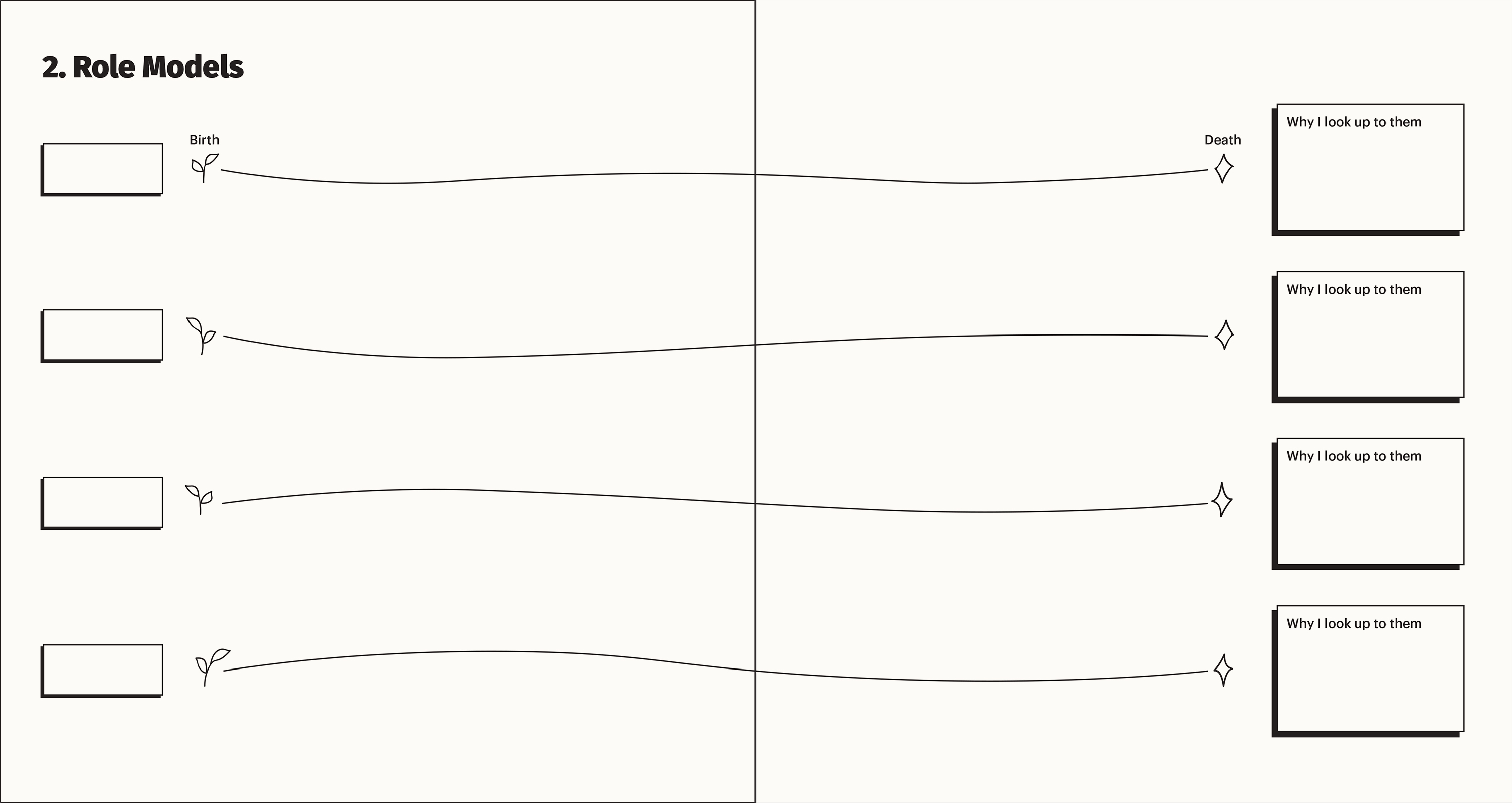
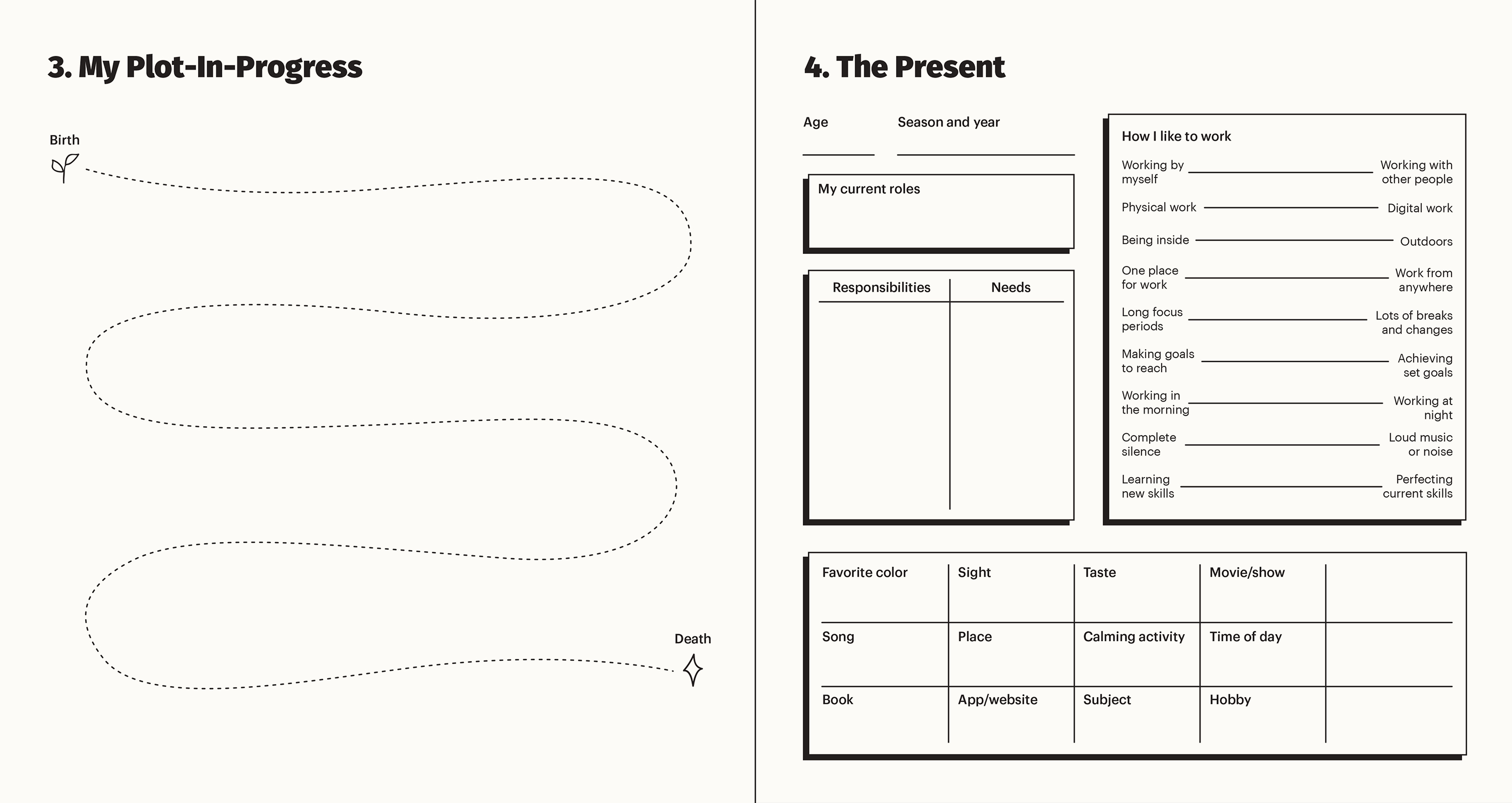
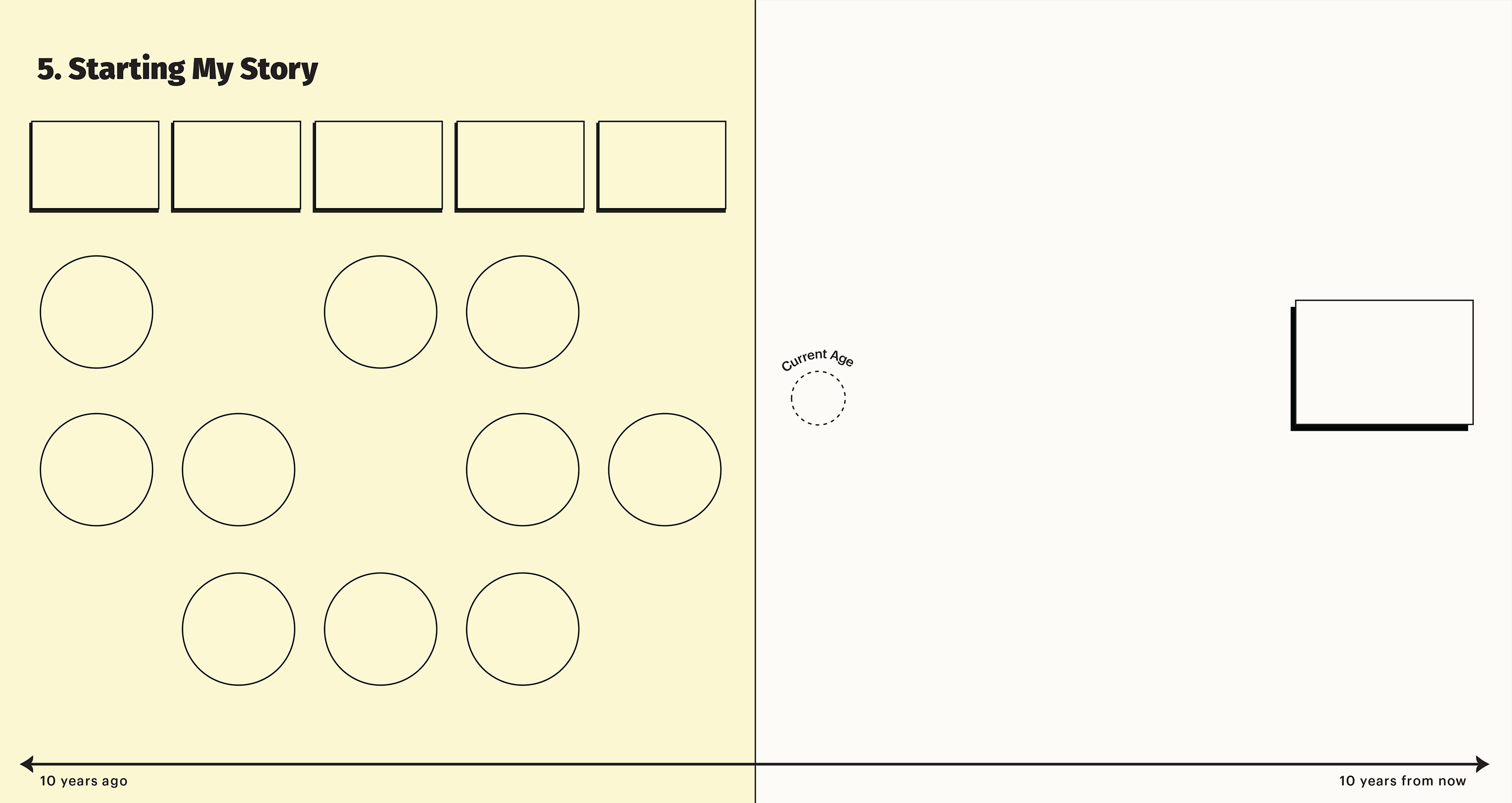
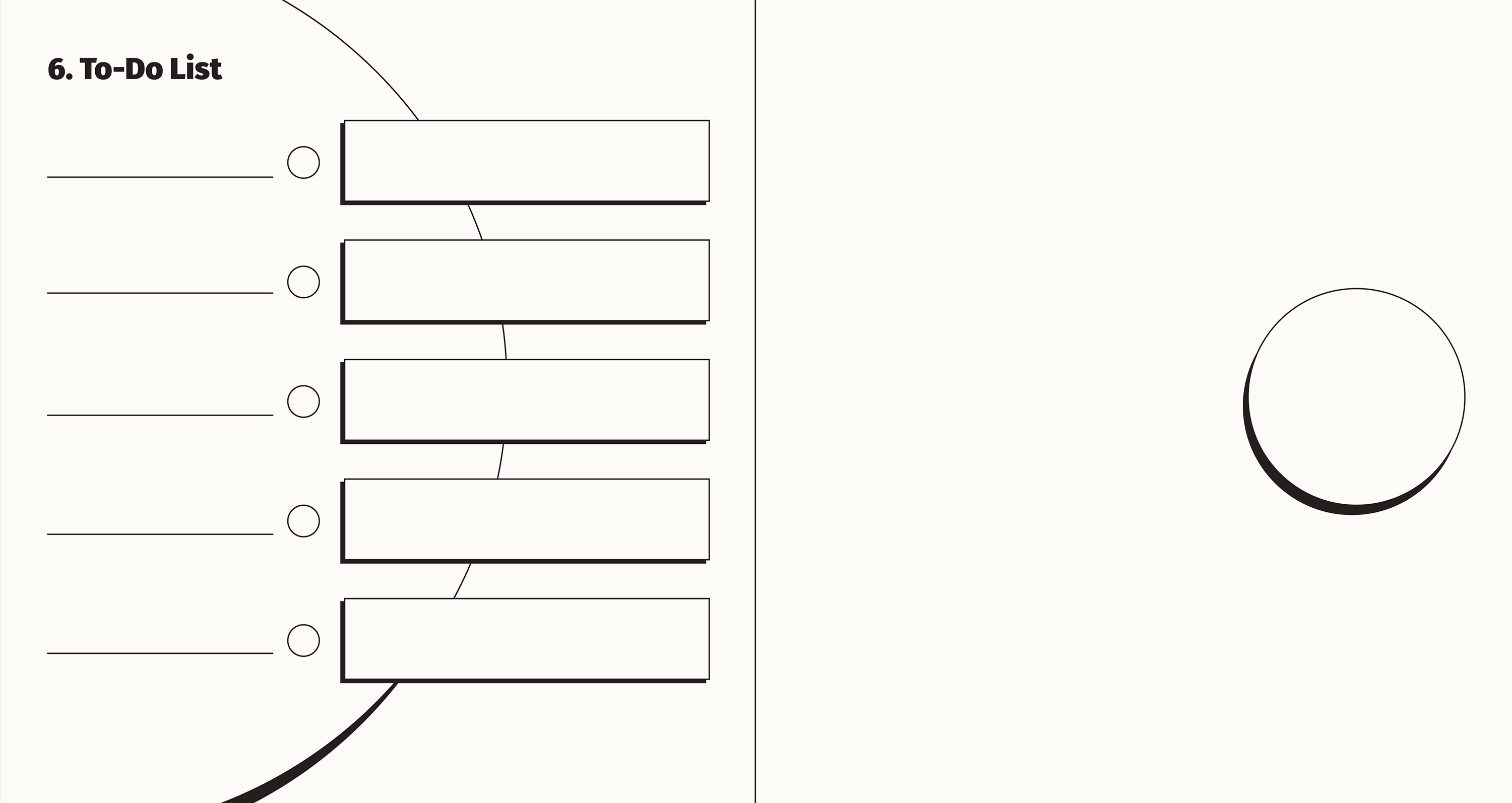
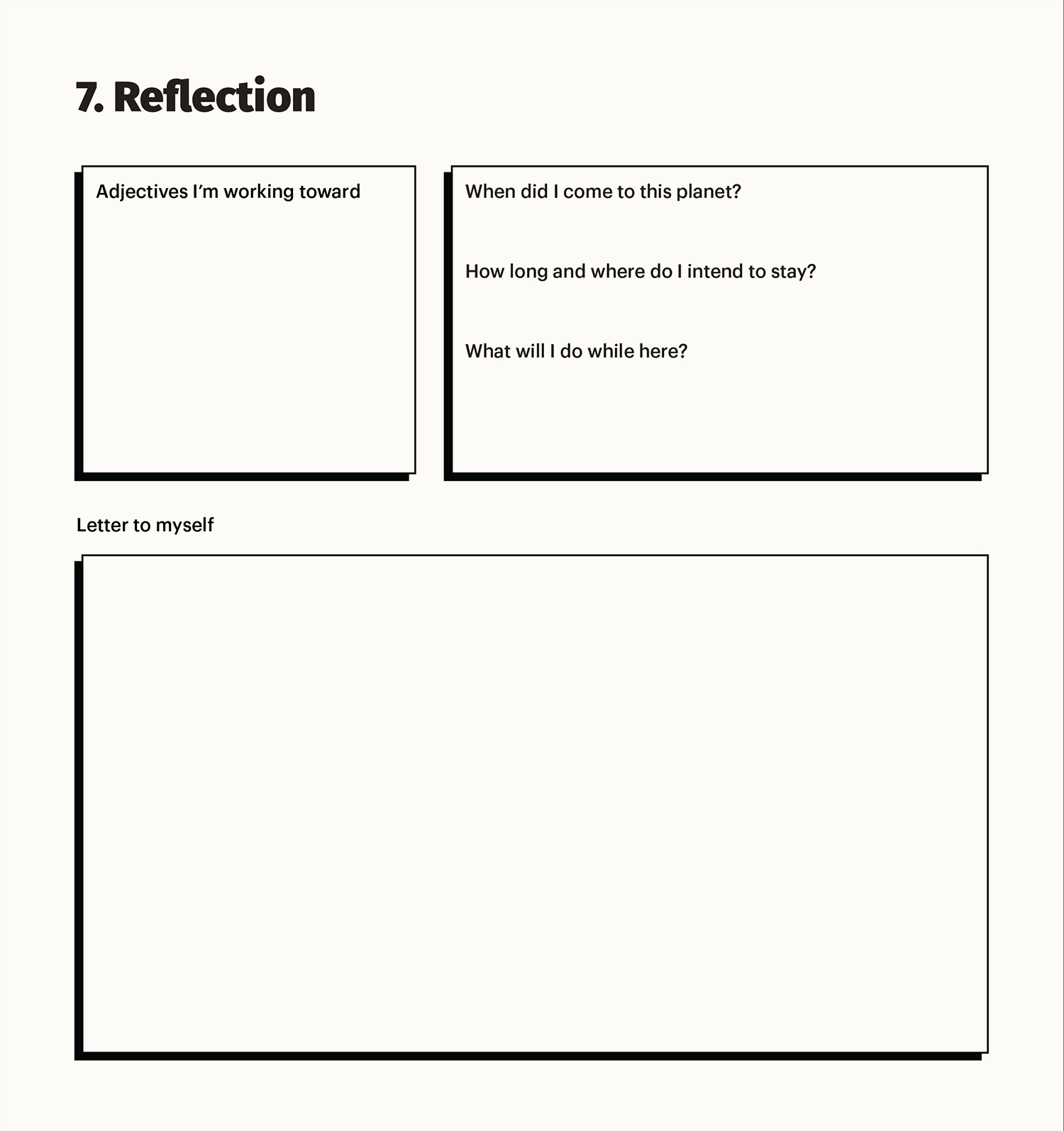 The Long Foldable Plot Twister is a 12-page accordion worksheet created for general self-reflection about life, goals, and role models, meant to be completed chronologically. This worksheet lacks explicit verbal instructions in the booklet because, as a prototype, it was only ever used in facilitated sessions with Jenny.
The Long Foldable Plot Twister is a 12-page accordion worksheet created for general self-reflection about life, goals, and role models, meant to be completed chronologically. This worksheet lacks explicit verbal instructions in the booklet because, as a prototype, it was only ever used in facilitated sessions with Jenny.Designed as a guided journaling activity with a facilitator, the Long Foldable Plot Twister is both our longest worksheet physically and the worksheet that focuses most on life through a long-term lens. Part 1 begins with an exercise to document the top five milestones in the last 10 years of a storyteller's life in the bolded rectangle boxes. Below each milestone, the storyteller writes three takeaways or life lessons they learned from that milestone, until all the boxes and circles on the left page are populated. Each row of circles is connected by a horizontal thread, forming a Takeaways Thread that links to milestones in the future on the right page. On this page, the storyteller inputs future events, stories, and milestones that they believe align with the story told by each Takeaways Thread. The final boxes on the right, for example, may be filled with future career achievements or lifestyle goals. This spread uses a visual-spatial metaphor of a life narrative over time as a left-to-right (L-R) movement across the page.
The following few pages build on this metaphorical understanding of time and life narrative. Part 2 addresses the life paths of role models, using birth and death as the bookends. This formalized Jenny's vision that both birth and death are natural parts of life and should be discussed from an early age; by including it in even a role model life map, storytellers are encouraged to reflect on life, even the lives of people they look up to most, as a finite opportunity to be created. Similarly, Part 3 is called "My Plot-In-Progress" to directly prompt the storyteller to think of their lives in the same way as they think about the lives of their role models: a narrative to invent with milestones and takeaways to collect.
Part 4 focuses on the present moment by providing the storyteller with questions that can serve as a time capsule of the storyteller's current favorite things, environmental preferences, responsibilities and needs, and roles in life at the moment. This activity serves as a rest stop after a few heavy activities of self-reflection, to interrupt the timeline-focused longitudinal view of life. Part 5 resumes this narrative creation exercise, however, by returning to the details from Part 1, which should already be copied onto the left side through carbonless copy paper (the storyteller should fill out the foldable in its accordion form to ensure this carbon transfer happens). Part 5 uses randomized selection to circle 10 takeaways from their original Takeaways Threads and asks the storyteller to compose a life narrative involving those takeaways to populate the right side. The storyteller is encouraged to add their own circles and ideas onto the blank space on the right, and further flesh those milestones out in the "To-Do List" activity in Part 6.
Finally, Part 7 ends the foldable with a reflection about values by prompting the storyteller to describe the adjectives they strive to embody and questions about their desired work, knowledge, and habits to manifest. This section closes with space for the storyteller to write a letter to themselves, to their current self, inner child, or future self.
The Quick Foldable Plot Twister
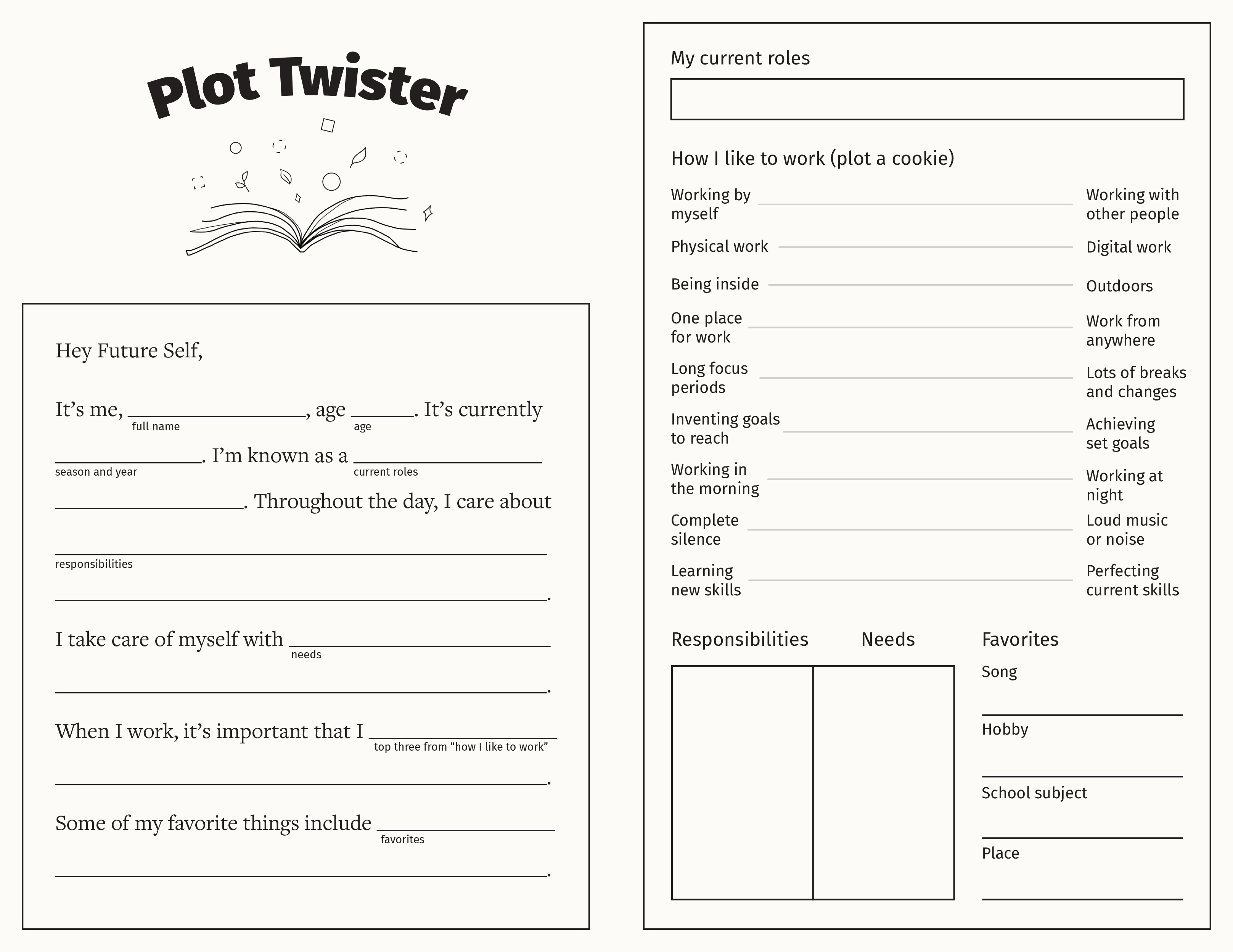
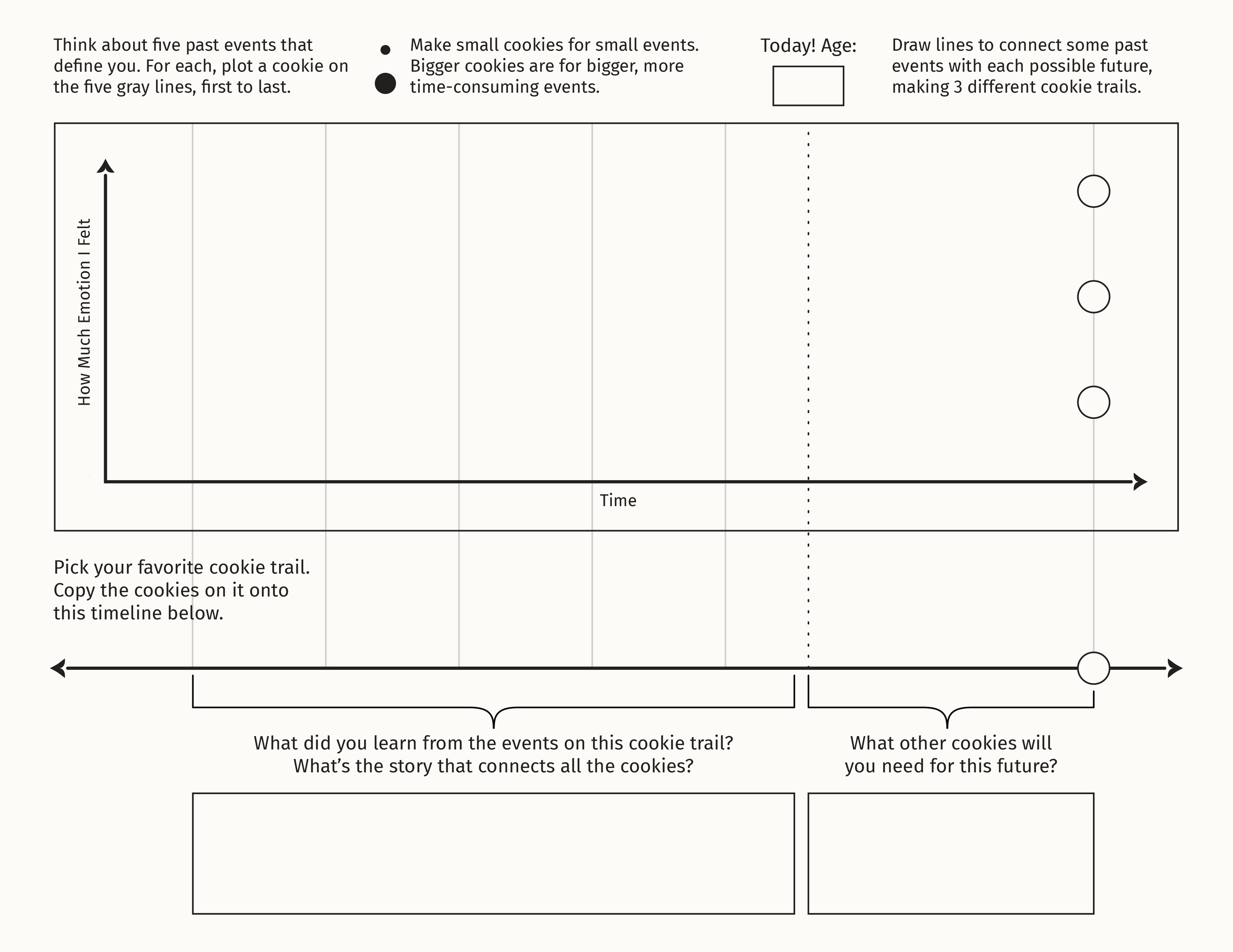 The Quick Foldable Plot Twister is a modified version of the Long Foldable Plot Twister that converts the L-R time-based life narrative concept into a briefer visualization format.
The Quick Foldable Plot Twister is a modified version of the Long Foldable Plot Twister that converts the L-R time-based life narrative concept into a briefer visualization format.The Quick Foldable Plot Twister is only 4 pages, as opposed to the Long Foldable's 12 pages, and begins with an ad-lib letter to self. Storytellers are encouraged to fill in the blanks, populate the boxes, and place a circle ("cookie") on a slider to externalize visually their current-day experience and preferences. This is intended to serve as a time capsule object for the storyteller to look back on later.
The inside of the Quick Foldable Plot Twister is detailed structure for composing a visual life journey. Introducing the metaphors of "cookies" and "cookie trails" to embody milestones and their connecting threads (like the Takeaway Threads from the Long Foldable), storytellers plot up to 5 events on the timeline horizontally, with their vertical position determined by a variable called "How Much Emotion I Felt" to indicate the emotional impact of the event. Jenny explicitly does not discriminate between "positive" or "negative" emotions and instead prioritizes memorability of the emotion.
After placing all 5 events and labeling them, storytellers also write three possible futures. These can be invented by themselves, suggested by a friend, randomly given by a career generator, etc. Similar to the Takeaway Threads activity from Part 1 of the Long Foldable, storytellers will connect past milestones and possible futures by drawing lines that they think could make sense or comprise a compelling life narrative. Afterward, storytellers pick their favorite invented life narrative to transcribe into the timeline below and reflect on their choice, the details of the narrative, and what it means for future intentions.
Cookie Trail Calculator
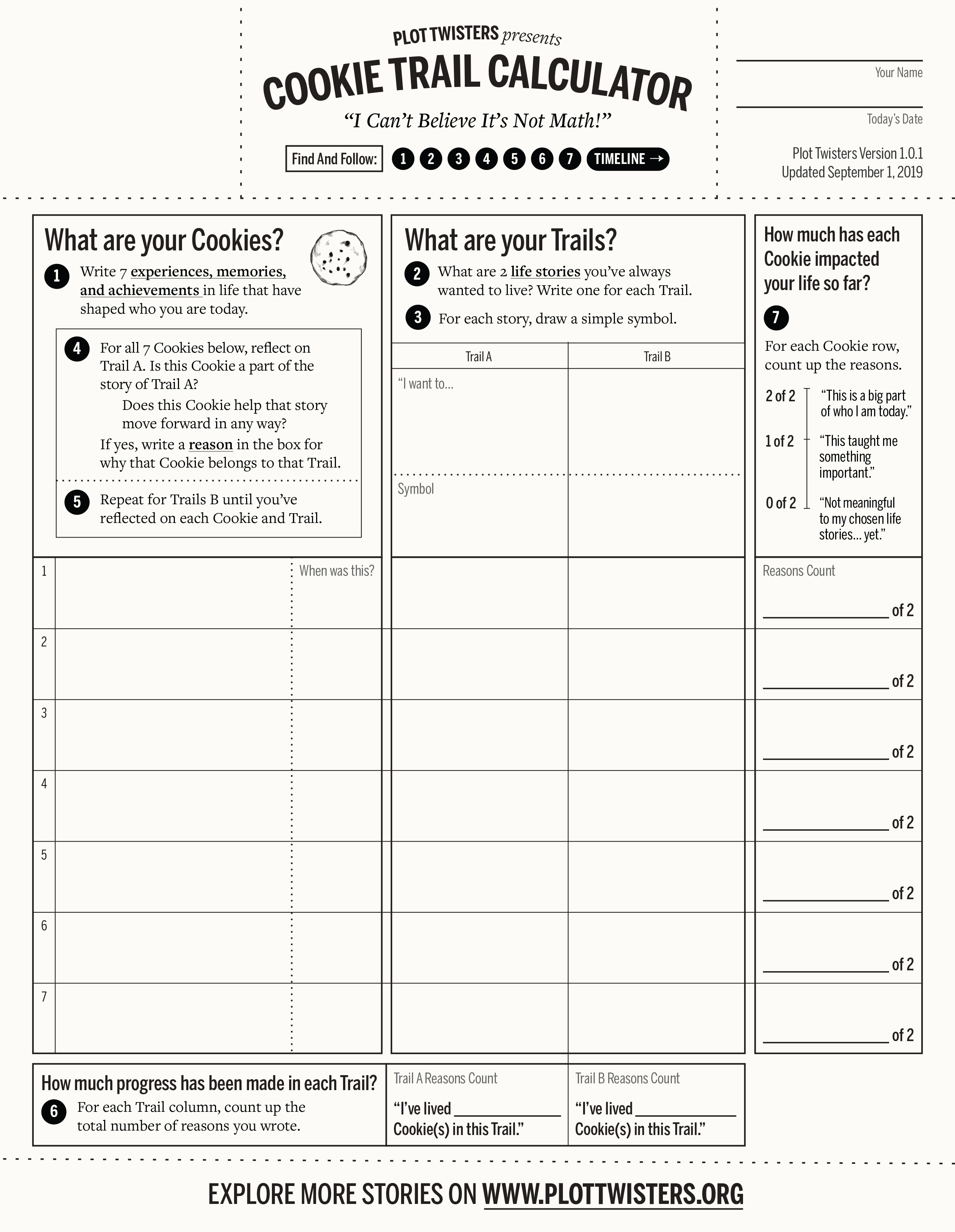 The Cookie Trail Calculator is an exploratory exercise for reflecting on potential life narratives, ambitions, and goals and our current alignment to them.
The Cookie Trail Calculator is an exploratory exercise for reflecting on potential life narratives, ambitions, and goals and our current alignment to them.The Cookie Trail Calculator takes the same quantified approach as the Homework Plot Twister but rather than reflecting on an isolated milestone or project, it asks the storyteller to make connections and evaluate certain narratives in their overall life journey. First, the storyteller is prompted to document 7 experiences, memories, and achievements that have shaped them, metaphorically referred to as "cookies." Second, they are asked to pre-determine two "cookie trails," or life narratives, that they have always wanted to live out. The storyteller then evaluates each of their 7 events and decides either "Yes" or "No" to whether that event contributes to the progression of each cookie trail, with the goal to visualize alignment of a storyteller's past with their future ambitions. Finally, for each event, they count up their "Yes" responses to quantify how aligned they are with their desired life narrative.
This worksheet is the first in an unfinished collection of worksheets designed for standalone, unfacilitated usage. While the above prototypes were all used in guided settings, the Cookie Trail Calculator was expected for use by people as a personal journaling practice. The visualization activity this was supposed to be paired with, the Cookie Trail Timeline, was not finished. However, a close analog can be seen in the above Quick Foldable Plot Twister.
Gift Tagger
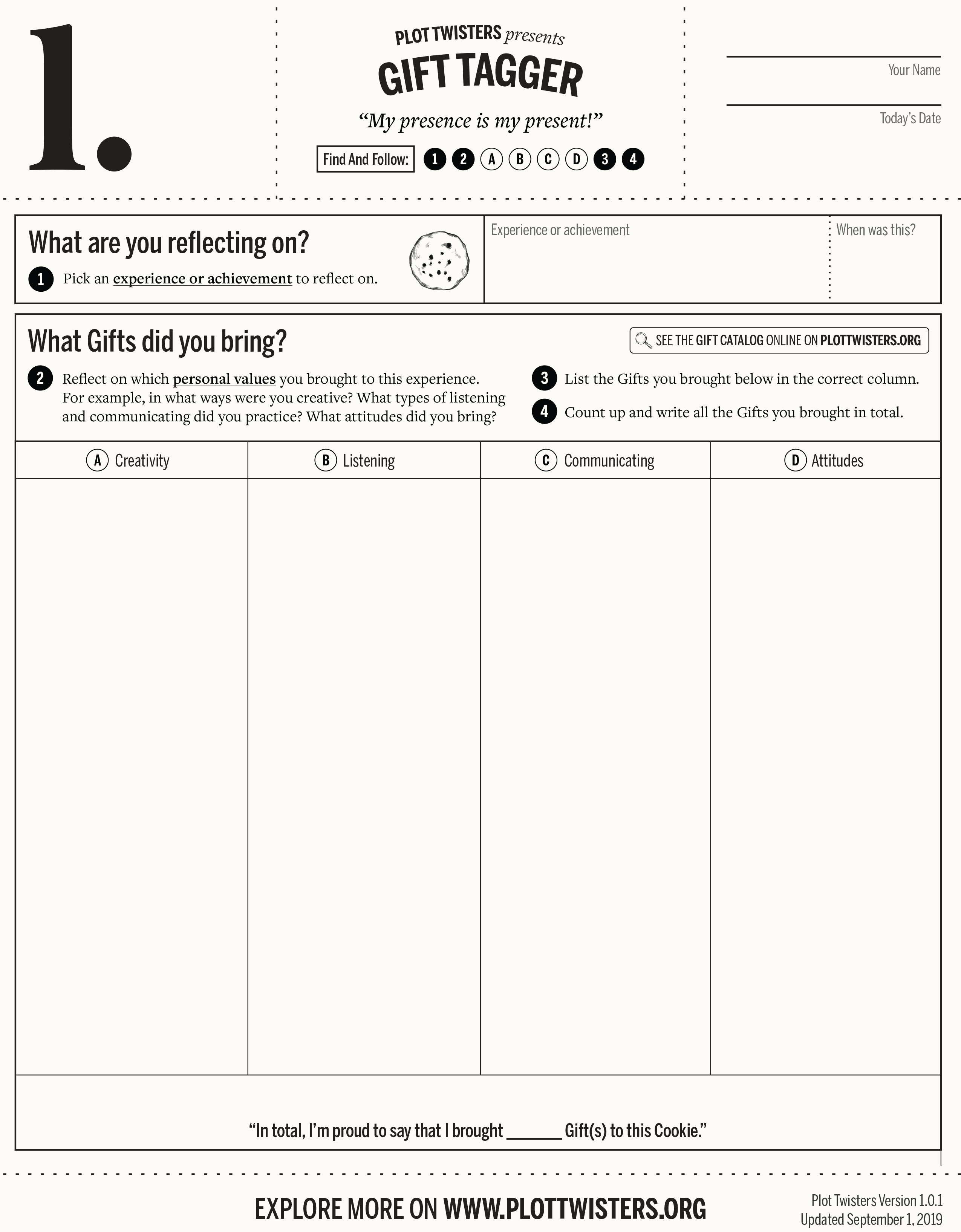 The Gift Tagger provides space for storytellers to deeply understand their values in the context of a specific event, milestone, or achievement.
The Gift Tagger provides space for storytellers to deeply understand their values in the context of a specific event, milestone, or achievement.Designed as a positive psychology practice, the Gift Tagger asks storytellers to reflect on the personal values they bring to an experience and evaluate how they relate to their creativity, listening skills, communication skills, and attitudes about life. As a semi-structured journaling activity, the Gift Tagger is supports storytellers to reframe their approaches to their learning, work, and play by considering how they can be positive strengths, or "Gifts."
Like the Cookie Trail Calculator, the Gift Tagger is part of an unfinished collection of worksheets for storyteller-led personal journaling. Nonetheless, we have recently found parallels for the Gifts metaphor in strengths-based mutual aid and resilience psychology practices; we are excited to examine these applications and integrate takeaways from the Gift Tagger into the world building of the Plot Twisters game.
References
Lakoff, G., & Johnson, M. (1980). Metaphors We Live By. University of Chicago Press.
Sontag, S. (2009). Reborn: Journals and Notebooks, 1947-1963. Farrar, Straus and Giroux.





